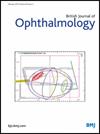户外活动可以预防远视儿童的近视,但对近视前儿童的保护作用较弱:一项随机分组试验的事后分析
IF 3.5
2区 医学
Q1 OPHTHALMOLOGY
引用次数: 0
摘要
目的探讨户外活动时间对近视儿童近视转移的影响。方法采用聚类随机试验对上海户外活动减少近视(STORM)研究进行事后分析。STORM研究中没有近视的6至9岁的参与者在2017年至2018年期间戴着手表监测户外时间。所有参与者都接受了单眼麻痹性屈光检查。通过可穿戴智能手表客观地监测每天的户外活动时间。近视眼定义为- 0.50至+0.75(含)屈光度(D)的单眼瘫痪球等效(SE)。从基线到随访1年,近视转移为SE变化。结果在3194名参与者中(1369名近视儿童,平均年龄8.2±0.6岁,男孩49.5%),近视儿童和远视儿童在户外活动时间上无统计学差异(p=0.303)。随着户外时间的增加,远视眼的近视位移减少(在120分钟/天左右达到平稳期)。然而,近视前期患者在户外活动时间与近视转移之间呈现出j型关系。与每日户外时间120分钟/天的亚组相比,尽管仍无统计学意义(>120分钟/天:0.04 (95% CI−0.05 ~ 0.14))。结论:在近视前儿童中,增加户外活动时间对近视转移的保护作用有限,建议延长户外活动时间或采取额外的干预措施来预防或延迟近视的发生。如有合理要求,可提供资料。本文章由计算机程序翻译,如有差异,请以英文原文为准。
Time outdoors prevents myopia in hyperopic children, but protection is weaker in premyopic children: a post-hoc analysis of a cluster-randomised trial
Aims To investigate the effect of time outdoors on myopic shift among premyopic children. Methods Post-hoc analysis was nested in a cluster-randomised trial of the Shanghai Time Outside to Reduce Myopia (STORM) study. 6- to 9-year-old participants without myopia from the STORM study, who wore wristwatches to monitor time outdoors from 2017 to 2018, were included. Participants were all examined with cycloplegic refraction. Daily time outdoors was objectively monitored with the wearable smartwatch. Premyopia was defined as a cycloplegic spherical equivalent (SE) from −0.50 to +0.75 (inclusive) dioptres (D). Myopic shift was SE change from baseline to 1 year follow-up. Results Among 3194 participants (1369 premyopic; mean age 8.2±0.6 years; 49.5% boys), there were no statistical differences between premyopic and hyperopic children in time outdoors (p=0.303). Hyperopes showed reduced myopic shift with increasing outdoor time (plateau at about 120 min/day). However, premyopes exhibited a J-shaped relationship between time outdoors and myopic shift. In comparison to the subgroup with daily time outdoors <60 min, the difference in SE change in the other subgroups was not statistically significant (61–90 min/d: −0.03 (95% CI −0.10 to 0.05); 91–120 min/d: −0.03 (95% CI −0.11 to 0.05)). The reduced myopic shift was only observed with time outdoors >120 min/d, although it was still not statistically significant (>120 min/d: 0.04 (95% CI −0.05 to 0.14)). Conclusions Among premyopic children, increased time outdoors has a limited protective effect on myopic shift, suggesting longer duration of time outdoors or additional interventions to prevent or delay myopia onset in this population. Data are available upon reasonable request.
求助全文
通过发布文献求助,成功后即可免费获取论文全文。
去求助
来源期刊
CiteScore
10.30
自引率
2.40%
发文量
213
审稿时长
3-6 weeks
期刊介绍:
The British Journal of Ophthalmology (BJO) is an international peer-reviewed journal for ophthalmologists and visual science specialists. BJO publishes clinical investigations, clinical observations, and clinically relevant laboratory investigations related to ophthalmology. It also provides major reviews and also publishes manuscripts covering regional issues in a global context.

 求助内容:
求助内容: 应助结果提醒方式:
应助结果提醒方式:


